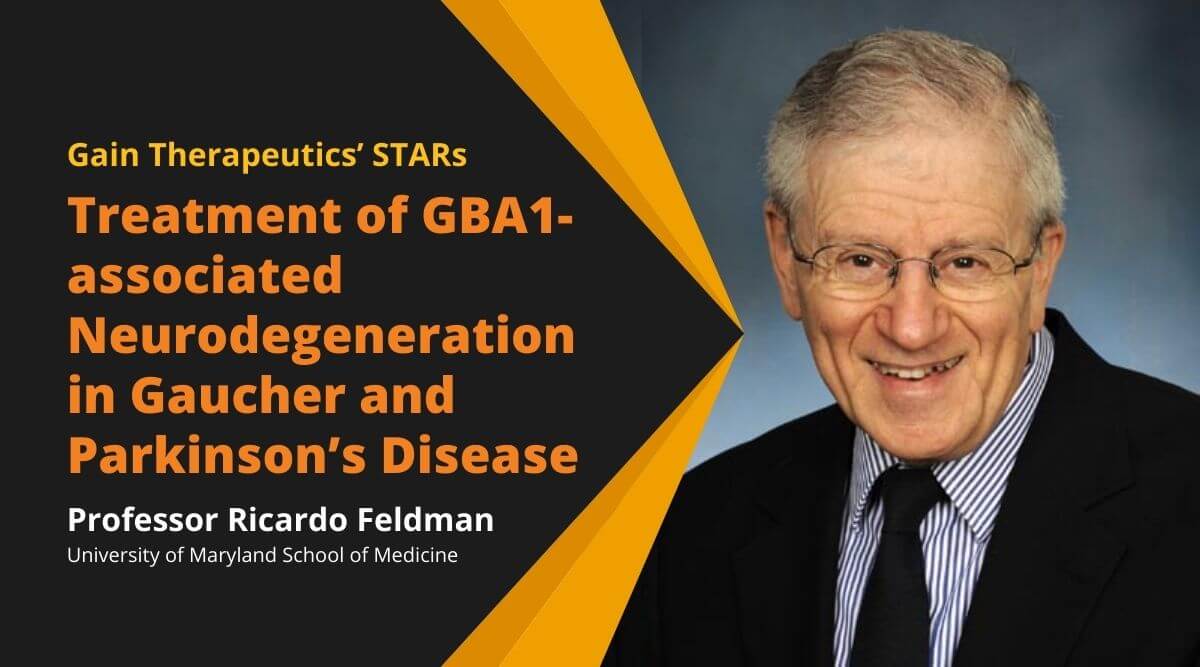Professor Ricardo Feldman, who is from the University of Maryland School of Medicine, gave a presentation about Gain Therapeutics STAR molecules for the treatment of GBA1 associated neurodegeneration in Gaucher and Parkinson’s disease at the Gain Therapeutics R&D Day. Watch the full presentation:
Transcript of Professor Ricardo Feldman presentation:
Thank you very much. I am very honored to be part of this group. These talks have been fantastic and I have learned a lot today.
I want to describe to you an in vitro system that we have been using to study Gaucher disease and, more recently, Parkinson’s disease. Can I have the next slide, please?
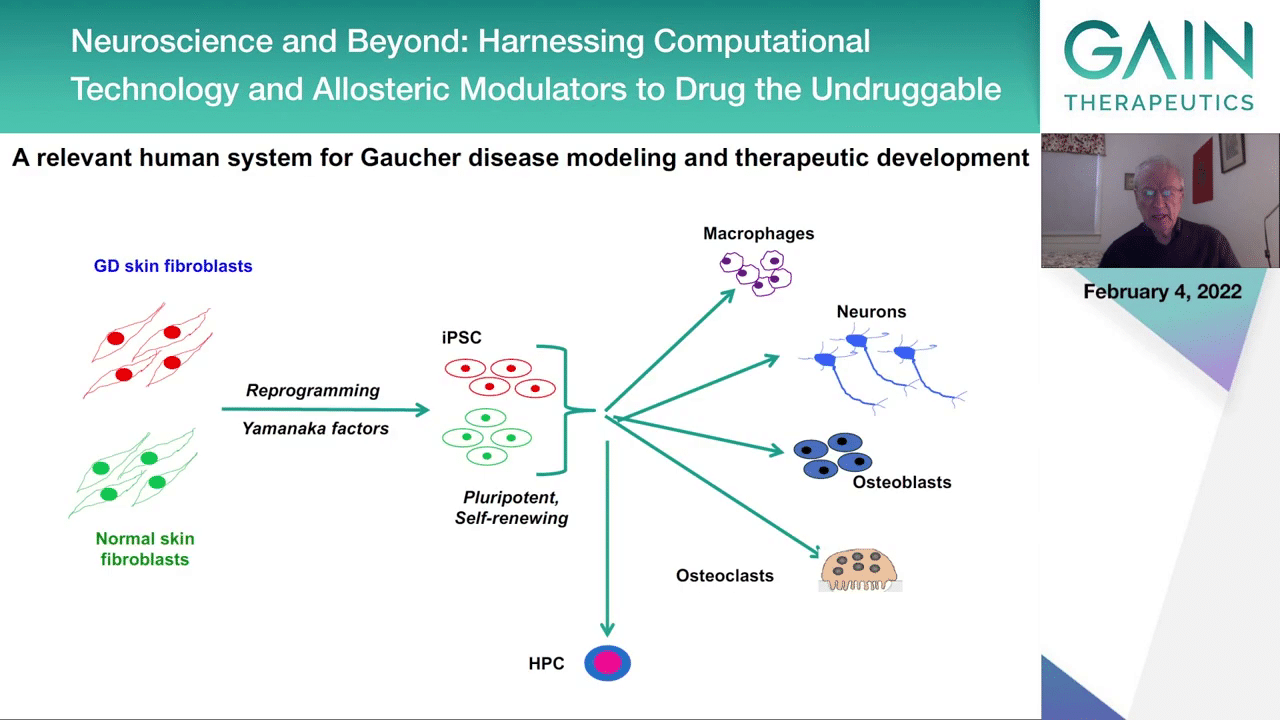
We have used induced pluripotent stem cells and these are cells that were derived from patients that have mutations, either in Gaucher disease or from normal skin fibroblasts. We have used reprogramming technology that was introduced by Shinya Yamanaka who got a Nobel Prize for this because he showed that by introducing some transcription factors into adult differentiated cells, he could go back to the pluripotent stem cell state, and that offers an advantage because if you have induced pluripotent stem cells they have two major properties: they are pluripotent, that means you can propagate them for long periods of time, and they are also self-renewing, and they can be differentiated into almost anything if you use the right environments. We have made in our lab macrophages. We have made neurons, osteoblasts, osteoclasts, and we have used this system to—we have been focusing on Gaucher disease, but as I said, we are now working on Parkinson’s disease.
We have found that in every single case the proteins, the cells, the cell types derived from the mutants have phenotypic defects.
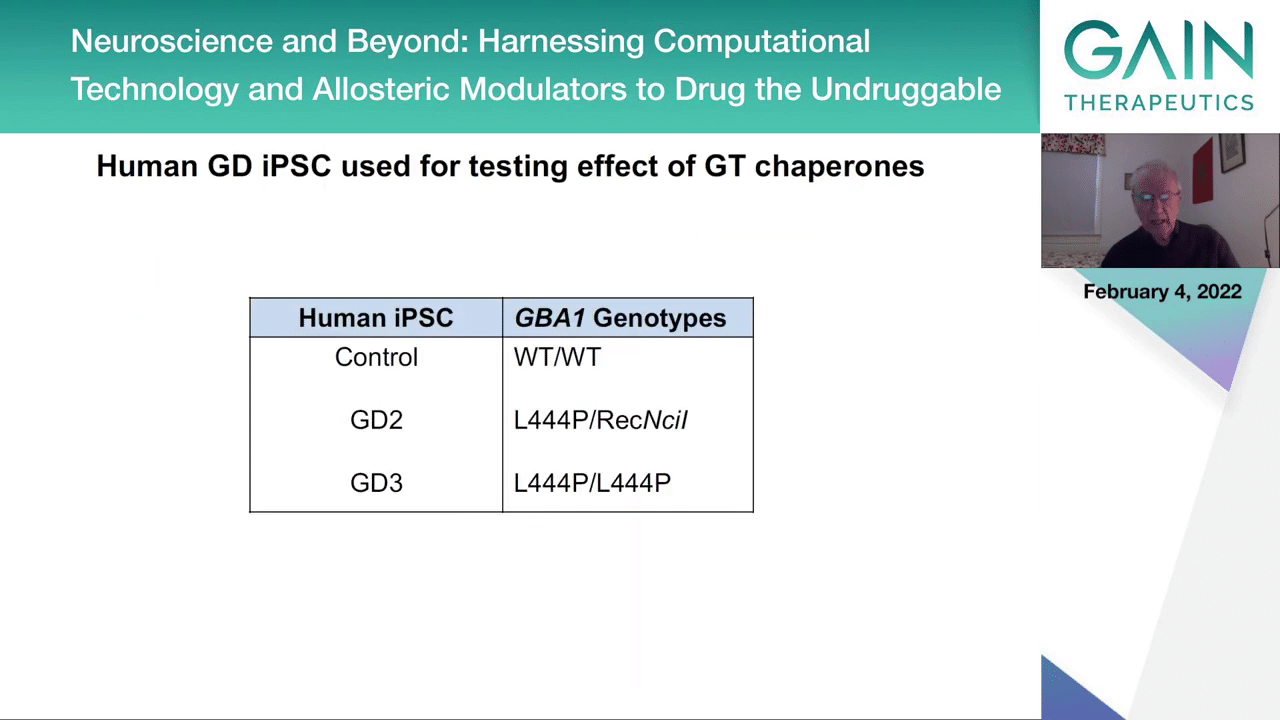
For GBA, for Gaucher disease we have used type 2 Gaucher disease cells and type 3 Gaucher disease cells. We differentiated them into cortical neurons and dopaminergic neurons, but also to macrophages and osteoblasts. GD2 and GD3 are the so-called neuronopathic Gaucher forms and that means that there is neurodegeneration, as opposed to type 1. Type 1 is the most common form of the disease, but it does not lead to neurodegeneration overtly. However, as we heard before, that people who have—even carriers who have mutations in GBA1 have a 5-fold to 20-fold increased risk for having Parkinson’s disease, and if you can sequence people who have GBA, people who have Parkinson’s disease, about 7% of them have mutations of GBA.
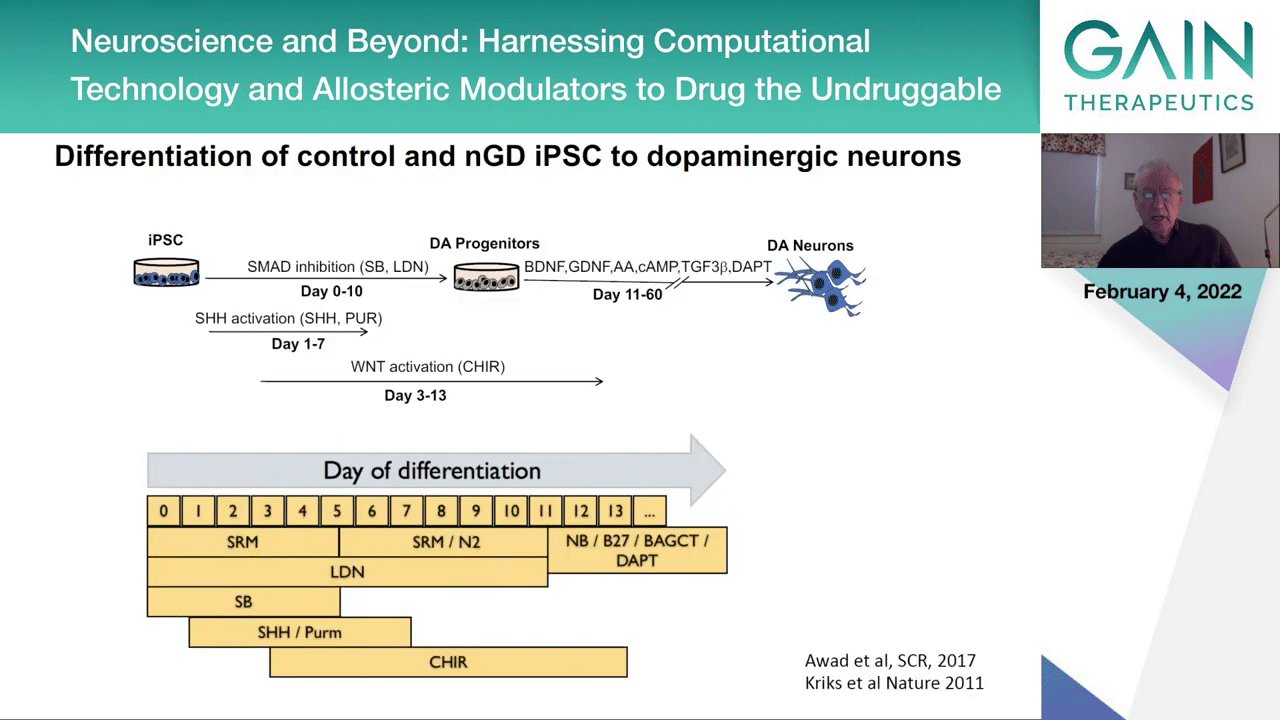
I have to say from the outset that this is only one way to address new drugs in the in vitro system, and this has to of course be validated in animal models but also in clinical trials. But these are human cells and they have the same mutation as the patient. Actually, they came from patients, and therefore we have the same genetic (phon) background in the patient. We can use well established protocols to differentiate them, as I said, to cortical neurons or dopaminergic neurons. Today I’m going to talk about the dopaminergic neuron defects from the patients who have mutations. But we have also done this work on cortical neurons and the results are similar; there is disruption of lysosomal functions.
When we have these induced pluripotent stem cells we use a cocktail of small molecules and then we go through different stages. We make dopaminergic progenitors in vitro and then we use growth factors and we incubate them for 45 to 60 days. Then we end up with dopaminergic neurons; they are not pure, they are 60%, 70%, 80% pure, and these are the different regimens. This is extremely complicated to do in vitro but the advantage is that at the end we have a cell that is quite relevant. These are not HEK cells or other cells that are used that are immortal. These are not immortal. These are primary neurons.
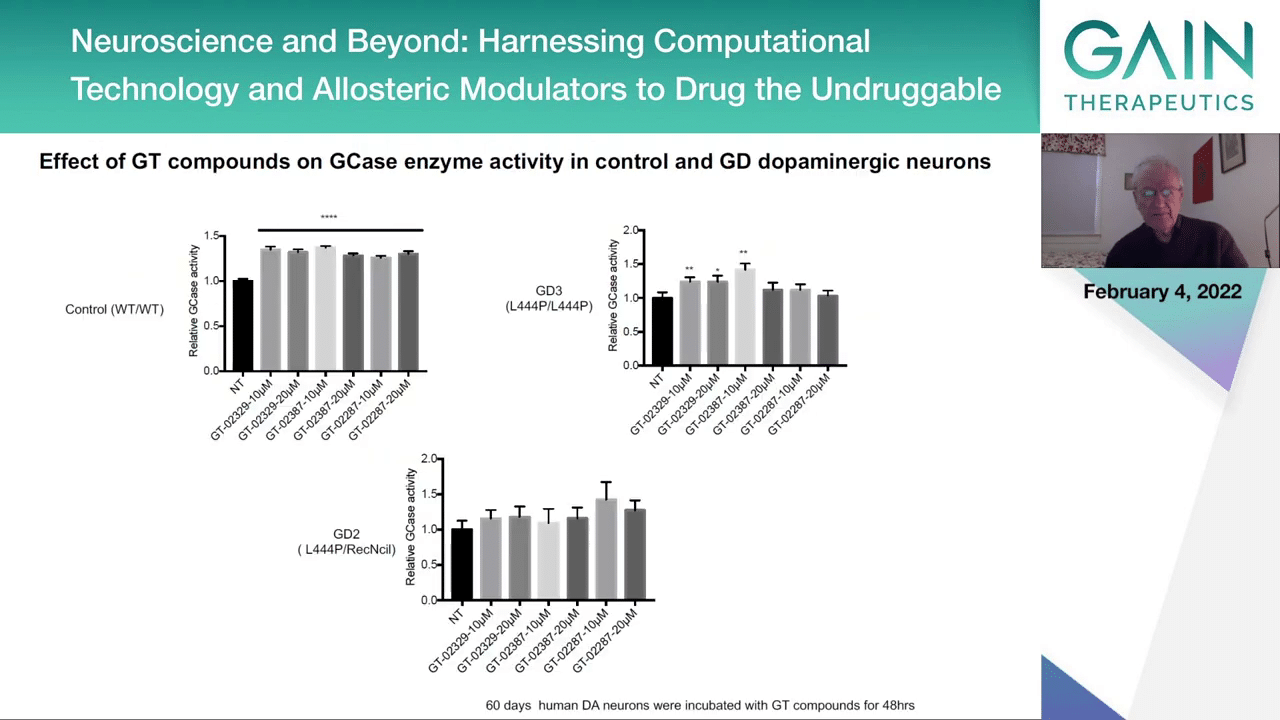
We have used three compounds (audio interference) have been already introduced and there is a third backup compound, 02387, and there are small differences between them but they all work. Here what I am showing you is the effect of the GT STAR compounds on the enzymatic activity in control and Gaucher disease dopaminergic neurons, and we look at the control here we can see that there is a very significant increase (audio interference) STAR treatments for today.
When we look at GD3, there is some variability here but essentially these compounds are active and when we looked at GD2, we didn’t achieve statistical significance here but there is a trend to increase the activity.
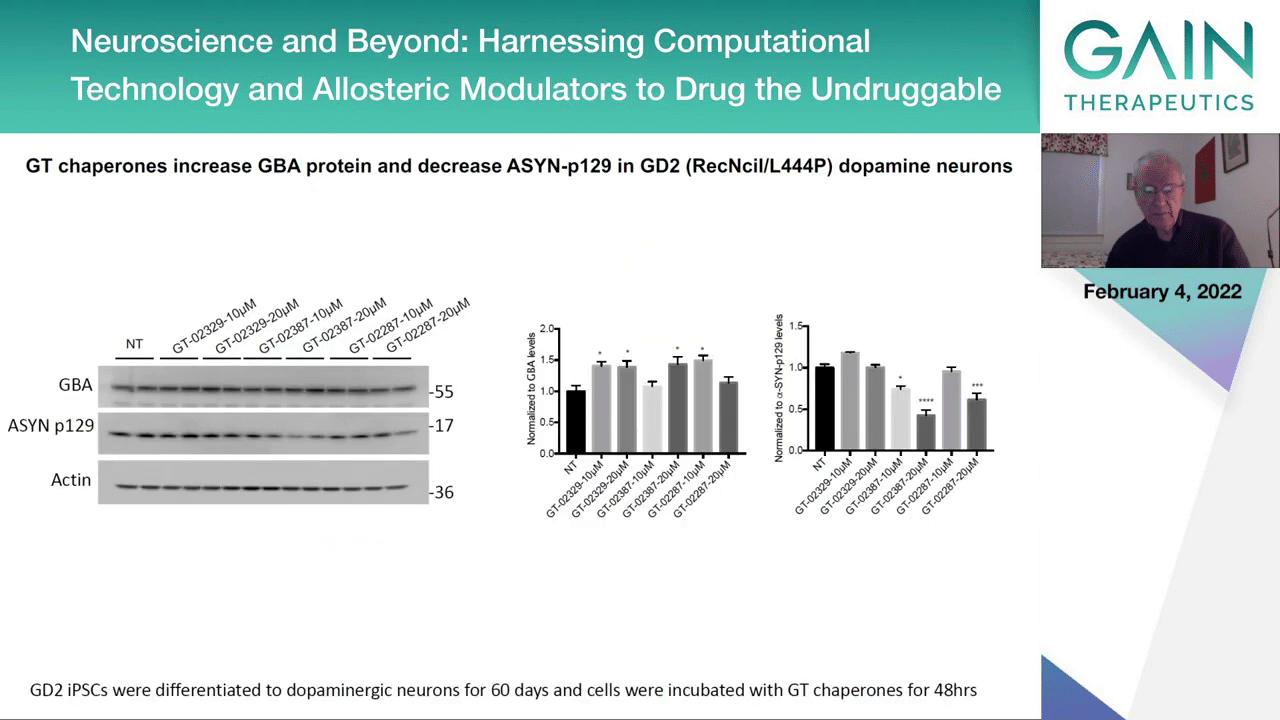
We have heard about alpha-synuclein P129 which is (audio interference) Parkinson’s disease, but these protein accumulations are not only in Parkinson’s but also in the neuronopathic Gaucher disease, dopaminergic neurons. Here we have Western blots showing the levels of GCase and alpha-synuclein 129 normalized to Actin, and here in the center we see that the GBA levels again—these are protein levels, not enzymatic activity like I showed you in the previous slide—and here we see that there is an increasing level of protein and I will show you later that there is not only an increase in the level of protein but also an increase in the transport to the lysosome. And, in general there are significant increases in the total level of protein. Then when we look at alpha-synuclein 129 there are these two compounds here that show significant decreases in the level of alpha-synuclein 129.
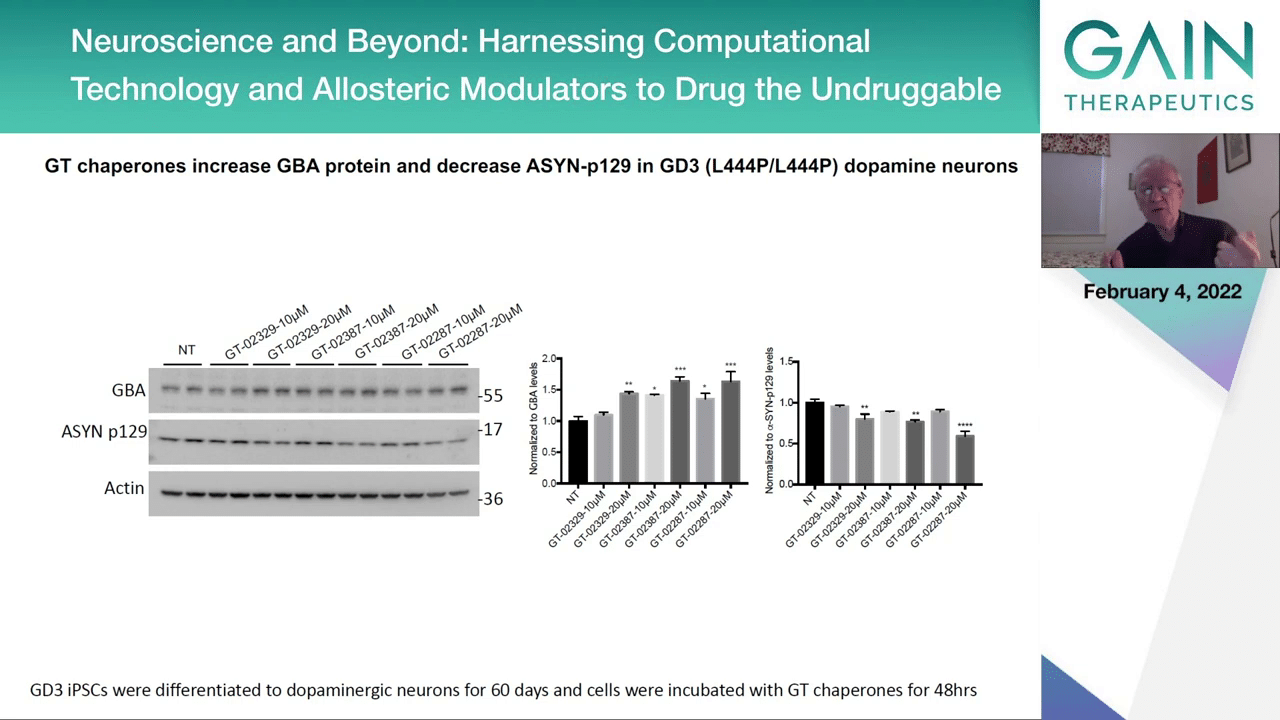
I want to point out that in the previous slide what I was showing you was the effect of these STAR compounds in wild type cells. In this slide we show the effects of these compounds in GD3, dopaminergic neurons.
Here again we see that particularly at the higher concentrations there is an increase in the level of total protein and essentially every one of the three compounds show significant decrease in the level of alpha-synuclein.
If I can have the next slide. Let me see. Can I go back one slide, please? This was GD3. The previous slide? That was GD2. The previous slide? Okay. Go back please, forward a couple of slides.
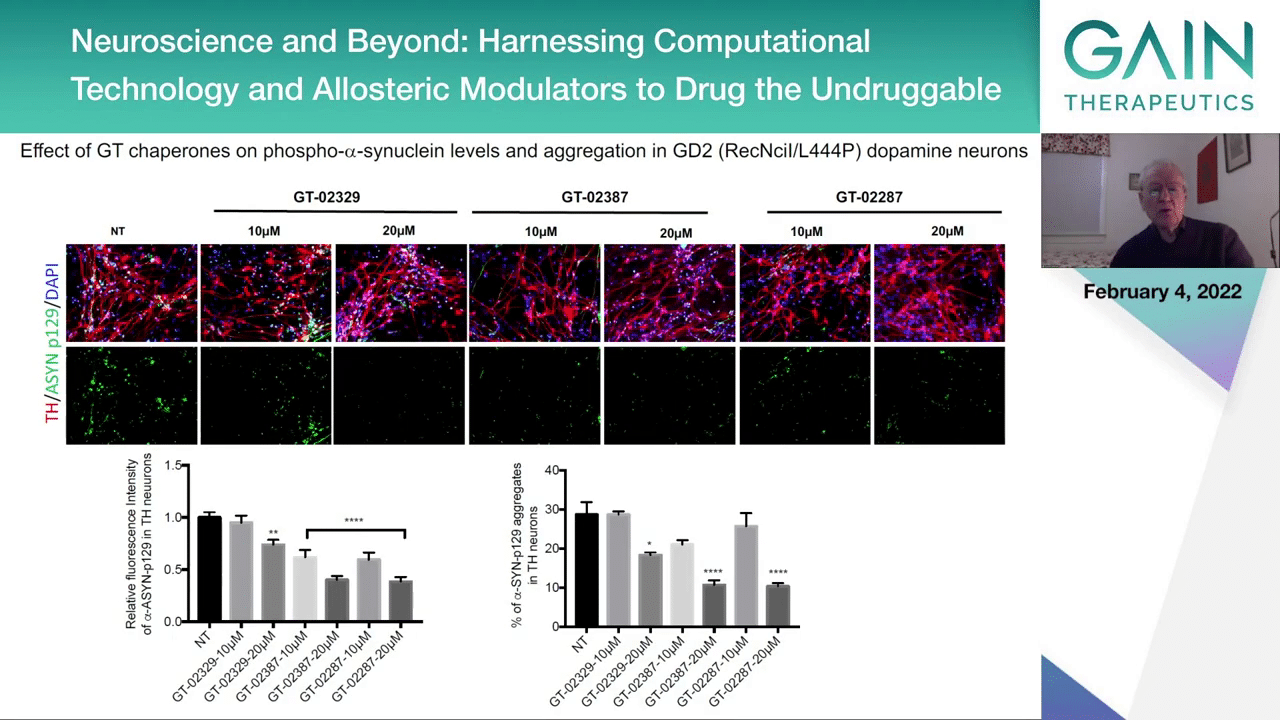
What we are doing here is we are using immunofluorescence and confocal microscopy to see what is the fate of the proteins in the mutants in the presence of the three compounds. We looked at tyrosine hydroxylase, which as has been mentioned previously is a marker of dopaminergic neurons. Here at the very left we have non-treated cells, and in the green is the level of alpha-synuclein 129, and the red is tyrosine hydroxylase.
When we look at the quantitation, again, by immunofluorescence I showed you the quantitation of the alpha-synuclein 129 by Western blot, but here we are confirming what we have seen by Western blot, that there is a decrease in the total levels of alpha-synuclein 129. You can see this here in the green, there is a decrease when we use each one of these three compounds at the two different concentrations.
Here we look at the alpha-synuclein 129 and then we quantitated the poncti (phon) indicative of alpha-synuclein aggregation, and again, these compounds were able to reduce also the levels of alpha-synuclein aggregation.
This is GD2. Can I go one slide before? One slide before? Okay. Sorry, let’s go back forward.
This is happening then in GD2 and in the next slide I showed you in GD3, and if we go one more slide, let’s go to the next slide, please.
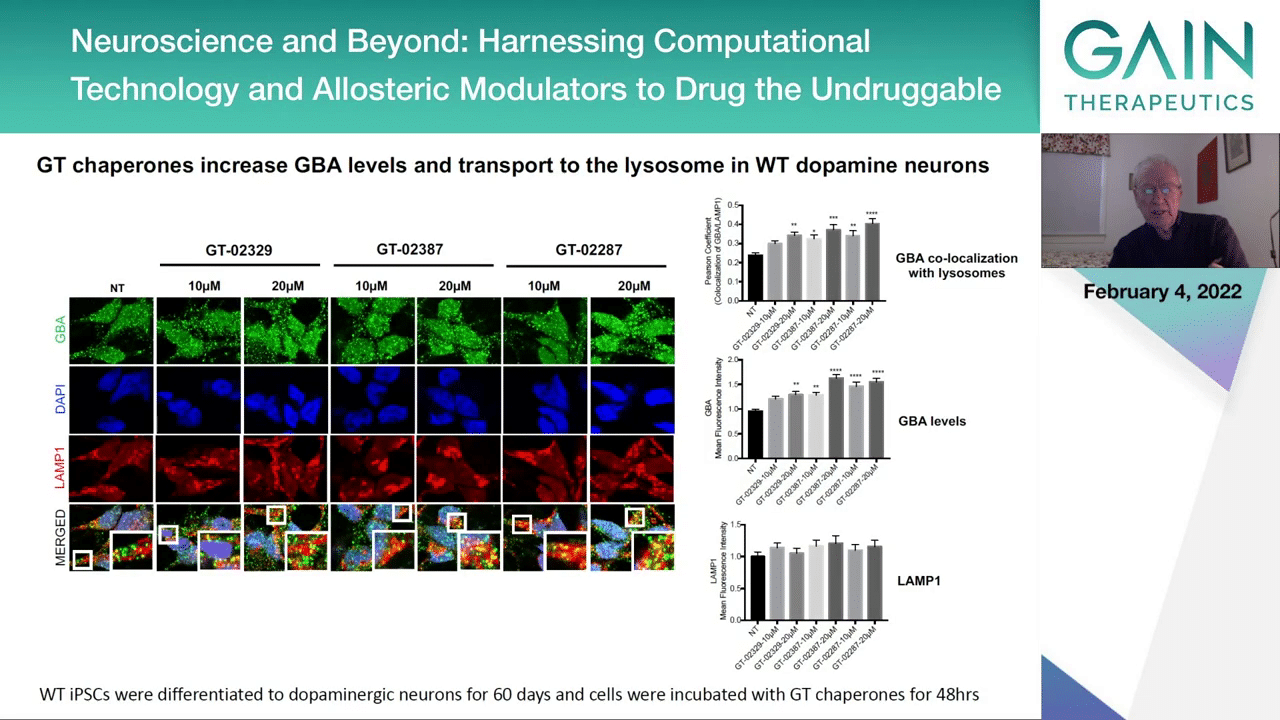
(Audio interference) and we saw that we have the total levels of GBA and this is shown here in this middle panel here that there is an increase in GBA levels, as we saw with the Western blot, and this is the green here. Then when we look at LAMP1, which is a third panel here, we didn’t see much change, but when you look at the co-localization using quantitation, call it Pearson coefficient (audio interference) and LAMP1, dopaminergic neurons.
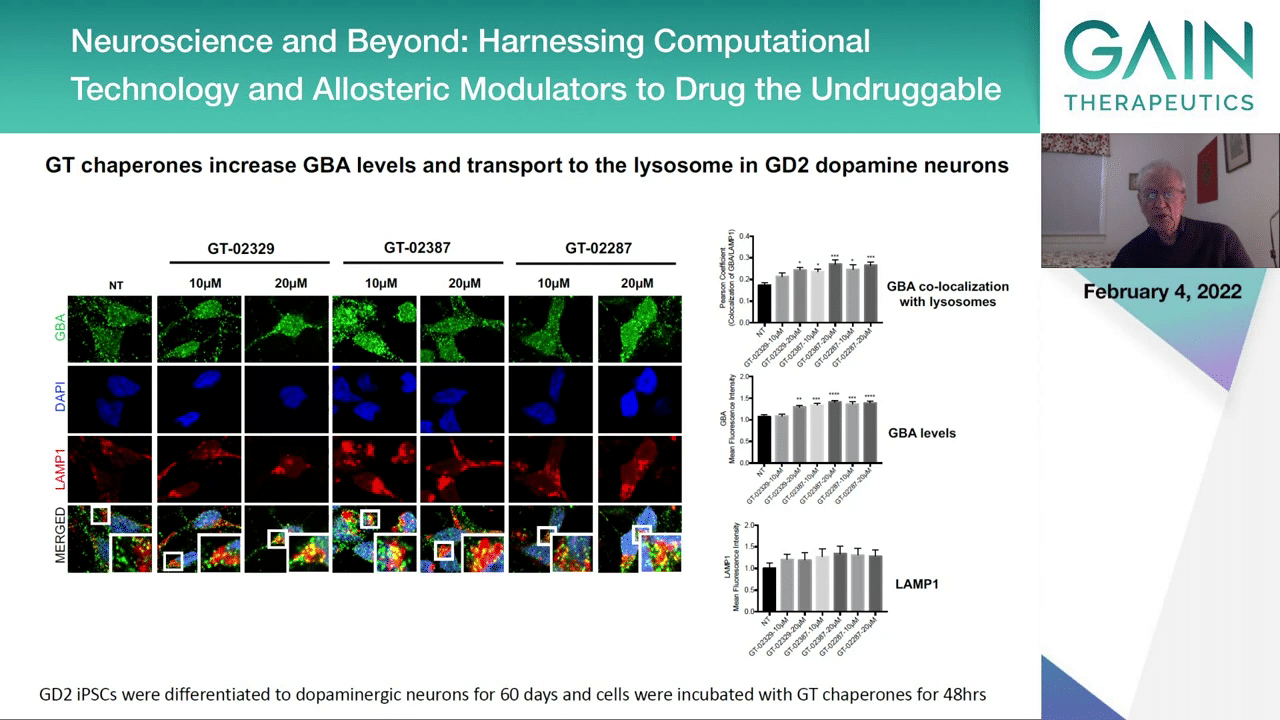
This is also happening, this Pearson coefficient is higher in the presence of the three compounds and there is also an increase in GBA when we quantitate from the images or GMA levels, and we didn’t see much difference in the total levels of LAMP1, but there is an increased co-localization.
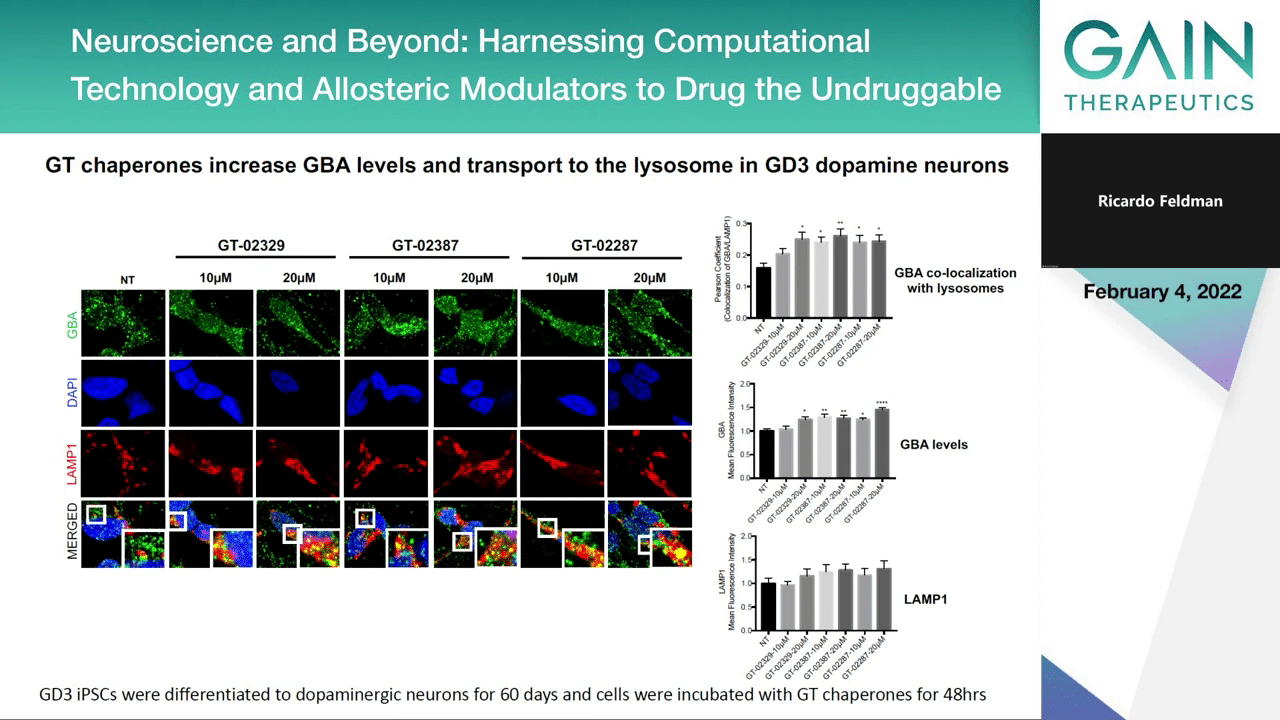
If we go to the next slide, in GD3 it’s the same thing. We see an increase in the co-localization between GBA protein, the GCase protein and the lysosomes, and there is an increase in the GBA levels in GD3.
I think this is my last data slide. Can we go one more?
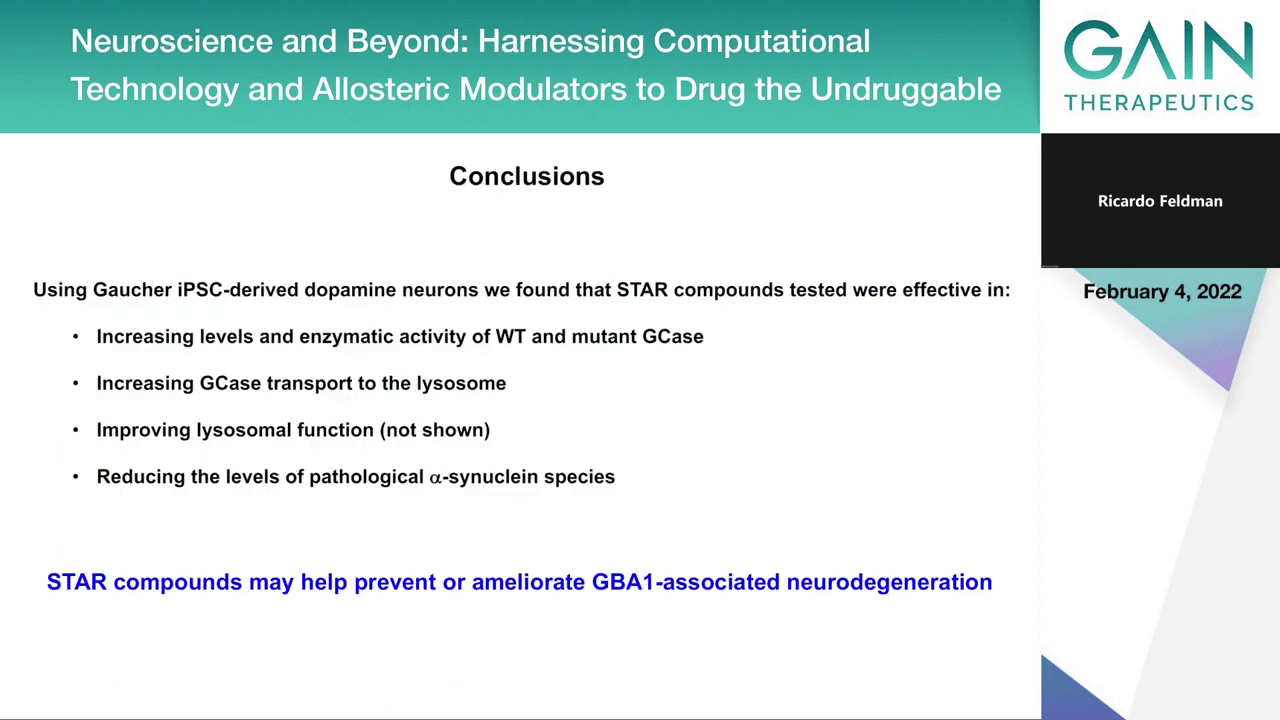
The conclusions. We used an in vitro system with Gaucher iPSC-derived dopaminergic neurons and we found that the STAR compounds tested were able to increase in levels and the enzymatic activity of the wild type and the mutant GCase, and we were able to increase GCase transport to the lysosome. There was an improvement of lysosomal function. That is not shown here but it was done by measuring autophagic flux. We reduced the levels of pathological alpha-synuclein species.
We have done a similar study that we just completed with cortical neurons and we found again increased transport to the site, to the lysosome, and we found increased levels of enzymatic activity and increased levels of protein.
We are just starting now growing the cells to do the same for dopaminergic neurons derived from patients with Parkinson’s disease that are carriers of these GMA mutations. In other words, these are heterozygotes. In other words, they have a wild type GBA GCase allele and they have a mutated one, and we iPSCs from the patients and one thing that we have to—I have to emphasize is that these patients have one type—one wild type allele and one mutant allele, but that these compounds as we saw with the Gaucher control the wild type, that has two wild type alleles. These STAR compounds do increase the activities of GCase in the wild type. I haven’t done the experiments yet, but I expect that since this works wild type, at the very least these compounds should be expected to increase the activity of the wild type enzyme that all these patients have, and they will also increase to various degrees the activity of the mutant allele.
We believe that these STAR compounds may help prevent or ameliorate GBA-associated neurodegeneration in Gaucher disease and likely in Parkinson’s disease.
I want to thank you for your attention and I will be happy to answer questions when we look at that chats if anybody.
